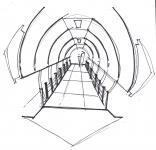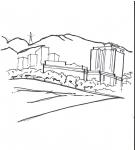One such principle is Serial Vision which was elaborated and discussed in the book ‘The Concise Townscape’ by the one who coined the term, Gordon Cullen. Architecture has the power to grab your attention and lead on to a path predestined. Several principles work together to make this possible. Serial Vision revolves around working on a set of revelations and at the same time keeping the interest and contrast to upkeep the stimulation and create a vibrant environment. A straight road or a simple rectangular building may seem monotonous to the viewer as he or she tends to absorb all of its glory and depth in a single frame or glance. Whereas, little attention to the orientation and scales can curate a sense of curiosity and element of surprise in the viewer often guiding the person in a certain direction. Serial vision takes its ultimate form when architecture and urban design take shape to form public art forms; one in which the observer does not have a choice to turn back but to pass through it. This huge responsibility lies in the heads of the urban designers and architects and hence, the competition to render perfect results.
1. Central Park, New York, USA
Frederick Law Olmsted took up the challenging task of giving the city dwellers a public park that would be 100% manmade and yet look natural. At a time where French formal gardens were considered the best, Olmsted opted for an informal approach. A natural setting that is highly monotonous would lose the sense of place with every visit. The design is focused on the point of view of a moving person and hence designed to reveal more with every step or passing corner. Inconsistencies of small pathways leading to huge open spaces followed with narrower spaces, finally leading onto a water body, keep the spark of a viewer alive. Moreover, the park never seems to cease at the edges, but with a little spillover into a street or a pedestrian path.
This putting together dynamic components in an informal design approach is a classic example of the application of serial vision.
2. Kuala Lumpur, Malaysia
The street bending through and creating new frames, unfolding something new in the field, thus, inciting curiosity and suspense. Speaking of curving and bending streets, Kuala Lumpur happens to focus on the irregular placement of streets and roads along with the incorporation of buildings of multiple scales, forming multiple frames and compositions. The application of serial vision is visible in the planning of several organic cities like Kuala Lumpur. Too much order and regularity in the streets and built forms of a town or city can suck out the life of a place.
3. Disneyland Paris, UK
Disneyland Park in Paris has a Fantasia Garden and Disneyland Hotel leading into the insides. The frames created as one, move from one point to another through this park is innumerable. With the perfect blend of manmade and natural elements co-existing to create awe and wonder in the viewers. The park emphasizes on disorder and asymmetry, that one needs a map to cover all the important spots or take a tour guide along. This also ensures that your visit is bound to be different each time you choose a different pathway. The park’s architects called this principle as an ‘arrival sequence’ wherein the visitors thought of having a choice on how to absorb the essence and feel of the place.
4. Taj Mahal, Agra, India
Known for its symmetry and order, you would be surprised to know how the principle of serial vision has been incorporated in this world wonder. Taj Mahal works on the principle of serial vision in a slightly different approach. Buildings of different scales are put together to form a composition. Passing by each of these, a new building is perceived or maybe a different perspective is formed. Multiple frames for the very same complex thus creates a stronger feeling of curiosity. This builds the enthusiasm of the visitor who moves forward in an intent to catch a better glimpse after witnessing the monument’s skyline as he or she enters the city.
5. Rashtrapati Bhavan, New Delhi, India
Designed by Herbert Baker and Edward Lutyens, the new capital was envisioned on the principles of Garden City. The Rajpath that leads to the Rashtrapati Bhavan has a series of visual screening as well as enhancing elements, thus, creating a progression of frames. A sense of progression is created and keeps the observer moving forward. The avenues and the water bodies confine you to the focal point and as you move forward your frame gets bigger with multiple buildings and different views.
An illusion of nearness and closeness that is created in the first frame fades out as one approaches the main building in focus, revealing more and more buildings of different scales and functions. In this example, serial vision is used to suggest the majestic and authoritative nature of the building in focus.
2022
Serial Vision technique
Tabriz city
Laleh Park aria
Urban studies
Tabriz Islamic Art University
Urban design Atelier 3
Fahmide square
Roshdiye
Eynali mountains
Amin Shahamipour
Morteza Mirgholami
Masoumeh Ayashm













